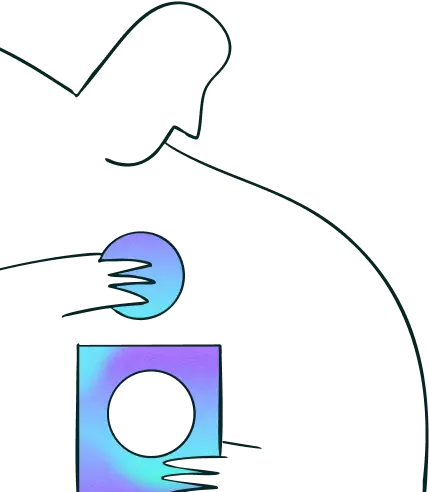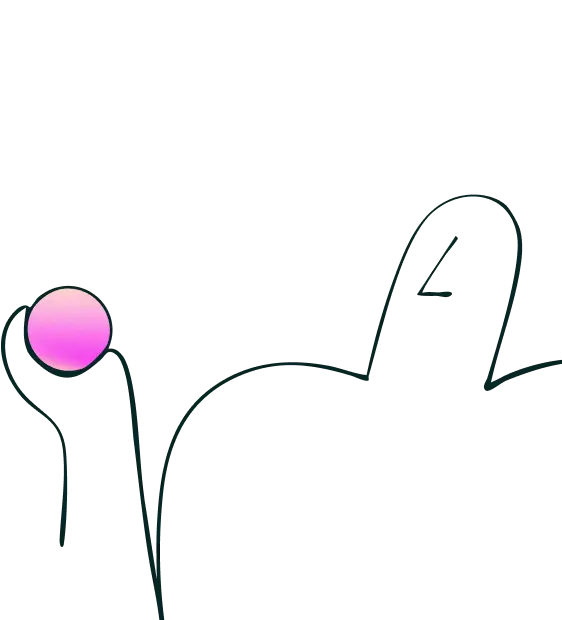04 Jun 2025
|12 min
Fintech UX design
Learn the importance of good Fintech UX design in this comprehensive guide. Plus, we share valuable best practices that will elevate your UX design skills in this advancing industry.

04 Jun 2025
|12 min

Imagine having all your financial needs just a click away. From managing your investments to sending money to friends and loved ones with just a tap on your phone, fintech has made it easy to do it all.
As one of the fastest-growing industries today, the global fintech market is expected to reach a value of US$936.51 billion by 2030. It’s also predicted to grow at a compound annual growth rate (CAGR) of 26.2% from 2022 to 2030. A good CAGR is 8% to 12% for large companies and 15% to 25% for high-risk industries.
As a UX or product designer, you’re probably curious how fintech differs from other sectors and what you need to consider when designing for fintech brands and organizations.
In this article, we'll explore the benefits of good fintech UX design, the challenges unique to fintech, and best practices for UX designers looking to break into this rapidly advancing industry.
Whether you're a fintech professional or a UX designer who wants to work in fintech, this guide is for you.
Fintech is the fusion of finance and technology. From mobile banking apps that allow you to check your balance and transfer funds to cryptocurrency exchanges that enable you to invest in digital assets, fintech has transformed how we manage our finances.
Here are some examples of fintech companies:
Neobanks (also called digital banks): Chime, Nubank
Mobile payments: Square, Venmo
International money transfers: Wise, WorldRemit
Investing: Gotrade, Wealthfront
Insurance: Oscar, Lemonade
Regulatory: Onfido, ComplyAdvantage
Lending: Kabbage, LendingClub
Cryptocurrency: Coinbase, Gemini
Blockchain: Chain, Bitfury
Fintech is the perfect example of combining convenience and innovation. However, creating successful fintech products is not without its challenges (discussed in more detail later in this article).
For example, fintech companies must navigate complex regulatory constraints while providing a seamless user experience that builds trust and credibility. For this reason, good user experience design is crucial for fintech products and services.
Fintech UX design aims to create seamless and user-friendly digital experiences for users of financial products and services.
"User experience design is like creativity you can express," shares Aine Ekoh, a senior product designer at JPMorgan Chase & Co. "I want to create a better user experience, and it's exciting when I can work toward a solution with my team."
Fintech UX design makes use of user research methods, UX principles, and patterns during product development process to make the user experience as intuitive as possible. A user in fintech can be a customer of a bank's digital platform or an employee of a lending company using their enterprise software.
The goal of fintech companies is to increase product adoption, which can be accomplished through positive, helpful user experiences. This means creating products that are easy to use, secure, and visually appealing.
Here are more reasons why investing in good UX design is a smart move that will pay off big dividends in the long term for fintech companies.
Customer trust is the most important currency in finance and banking. However, only 43% of individuals surveyed in Accenture's Purpose-Driven Banking study trust banks to have their best interests at heart.
Meanwhile, 56% of consumers under 30 would opt for digital banking solutions from tech giants if available. For these young consumers, big tech companies like Google and Apple, who prioritize top-notch UX and UI design, are likely to be trustworthy.
For financial organizations where trust is a precious commodity, investing in good user experiences could be the key to success for any finance or banking institution looking to appeal to younger consumers.
Security and privacy features that are more accessible and user-friendly can help build trust and confidence among fintech users, which is essential in an industry where data breaches and cyber attacks are a constant threat. For example, a Boston Consulting Group report highlighted that banking and financial organizations are 300 times more susceptible to cyber attacks than other sectors.
Conducting qualitative and quantitative research methods can help you gather useful user feedback so that you can create thoughtful designs that help users understand security best practices, like using strong passwords and enabling two-factor authentication. In addition, thoughtful UI design can help users understand how their data is being used and give them greater control over their privacy settings.
Turning complex processes into enjoyable user experiences isn't just a nice-to-have; it's a potential game-changer for boosting profitability for fintech organizations.
As an example, fintech companies can attract and retain more customers by taking the pain out of tedious financial tasks like applying for loans or managing investments. When your users are happy, they're more likely to spread the word and bring in new customers.
Good UX design can also reduce the risk of costly errors and increase efficiency, saving your organization time and money. Plus, with competition heating up in the industry, prioritizing UX design could be the key to standing out in a crowded marketplace.
Fintech companies face regulatory challenges that can be complex and confusing for users. UX teams in fintech can simplify complex regulatory information through clear language, helpful visuals, and smooth user flows.
Effective UX design can also ensure that users comply with regulatory requirements by guiding them through the necessary steps. This can be achieved through intuitive interfaces, clear instructions, and feedback mechanisms that help users to understand what they need to do.
Financial inclusion aims to provide financial products and services to everyone, irrespective of their wealth or business size. It eliminates barriers that prevent people from using financial products and services to enhance their lives.
Helpful and pleasant user experiences by fintech brands can address the hurdle of inaccessibility in finance and help devise new ways for individuals and organizations to obtain financial services easily.
Join over 320,000+ marketers, designers, researchers, and product leaders who use Lyssna to make data-driven decisions.
Creating user-centered and beneficial experiences for fintech is possible through the following tips and best practices.
Fintech has lots of jargon and complex topics you may need to familiarize yourself with. For instance, understanding account receivables involves knowing the legal definition of invoices, how fees are applied, payment plans, deferments, and more.
While you'll probably have access to subject matter experts, knowing relevant terminology is invaluable during product discovery, design, and development.
Fintech is a highly regulated industry, and users are almost always required to verify their identity when signing up for a product or service.
For example, new users of neobanks need to go through the KYC (Know Your Customer) process before they can create an account. Meanwhile, an AML (Anti-Money Laundering) check needs to be done before they can receive funds into their accounts.
“Potential customers will need to spend 5–15 minutes getting started and will have to wait for anything between a few minutes to a few days before an account is actually opened,” explains Jessica Lascar, Senior Product Designer at Cleo, an AI-powered chatbot that helps users manage their finances.
Jessica recommends:
“This is why it’s important to break up the registration steps into small chunks by focusing on one task at a time and organizing them into sections. Doing so will make the whole process a lot more digestible and provide the proper mental space to focus on the answers.”
Learn more: The pain of KYC in Fintech
Chime, a mobile banking app based in the US, is a good example. During registration, the app strategically requests only one crucial piece of information per screen and provides clear explanations for why specific personal details are required. On the other hand, legal terms are presented as clickable links, allowing users to access them as needed.
As mentioned earlier, finance is notorious for terms that may sound jargony and intimidating to your typical user.
When creating user flows and copy for fintech apps and platforms, work with UX writers and copywriters to use clear, concise, and consistent language throughout your product. Doing so can also help prevent confusion and build trust with users wary of financial products and services.
Monzo, an online bank based in the UK, illustrates this well with its simple and conversational tone throughout their app.
Gamification, or adding game design elements into non-game contexts, has become a widely used UX design best practice in fintech.
With game-like experiences, fintech companies can create engaging and interactive interfaces that help users learn about complex financial concepts, encourage responsible financial behavior, and increase user retention.
For example, Acorns, an investment app, uses the "Found Money" feature to reward users with cashback when purchasing at participating merchants.
Learn more: How Acorns' CMO James Moorhead Drives 99% Retention With Personalized Gamification and Customer Education
Similarly, Qapital, a savings app, allows users to make "Money Missions" to learn how to use their money in the present and utilize it better in the future.
These gamification strategies enhance the user experience and make managing finances more enjoyable and accessible for a broader range of users.
Positive friction is intentionally introducing small obstacles or hurdles in the user flow.
Adding friction to a product designed for convenience and ease of use may seem counterintuitive. However, positive friction in fintech UX design can help prevent impulsive or harmful actions and promote thoughtful decision-making.
“Financial apps are not like others, for two reasons. First, managing your finances and investments is an absolutely vital function because it guides your life through your spending. Second, many people struggle with understanding finance, and opt for hiring a financial advisor. For these reasons, financial apps should be treated with caution because of how much is at risk,” explains Alexandra Grochowski, former senior product designer for Amount, a fintech company based in the USA.
For instance, when a user wants to send money to someone, they typically enter the recipient's account number, name, email address, or phone number to initiate the transfer. In this case, you can introduce positive friction by requiring the user to verify the recipient's details before confirming the transfer.
This simple obstacle could help prevent common mistakes such as typos, misspellings, or sending funds to the wrong person with a similar name. It also helps ensure that transfers are accurate and secure, which could ultimately lead to a better user experience and greater trust in your brand.
Learn more fintech UX design best practices through the following resources:
Fintech UX design presents a unique set of challenges, but with the right approach and best practices, it can lead to helpful and enjoyable user experiences.
Before getting started with the design process, understanding user needs, preferences, and pain points is a top priority. This is where Lyssna comes in.
The best teams use Lyssna so they can deeply understand their audience and move in the right direction — faster.
--
Kai has been creating content for healthcare, design, and SaaS brands for over a decade. She also manages content (like a digital librarian of sorts). Hiking in nature, lap swimming, books, tea, and cats are some of her favorite things. Check out her digital nook or connect with her on LinkedIn.


Join over 320,000+ marketers, designers, researchers, and product leaders who use Lyssna to make data-driven decisions.
No credit card required